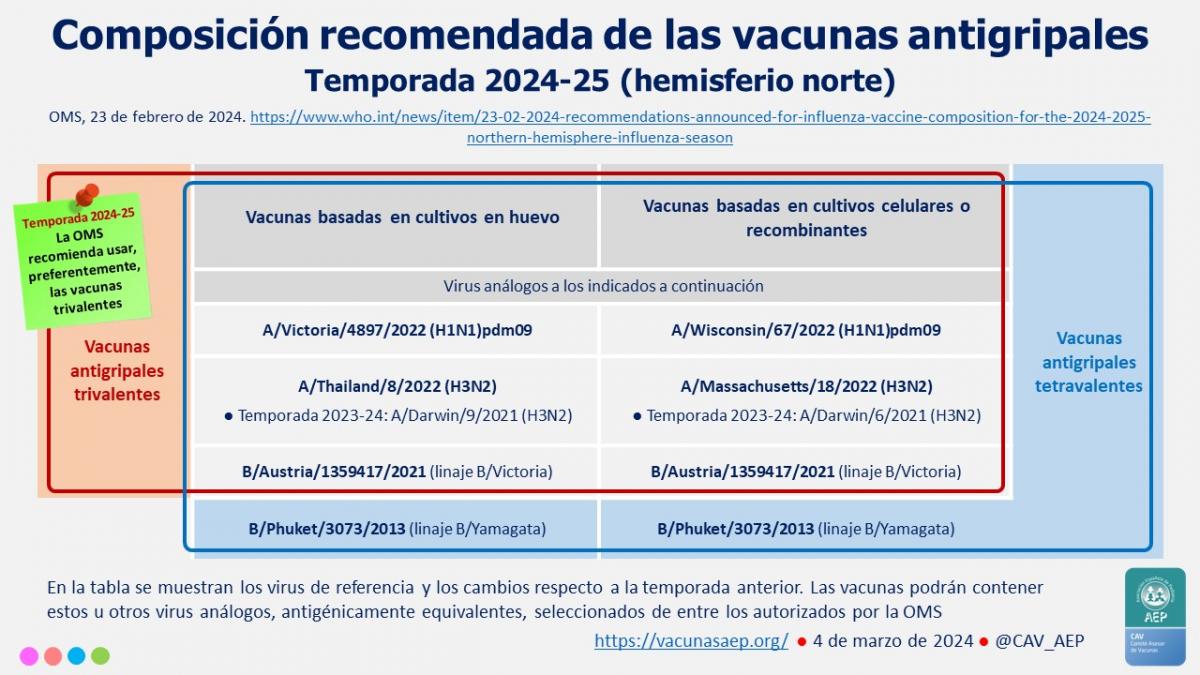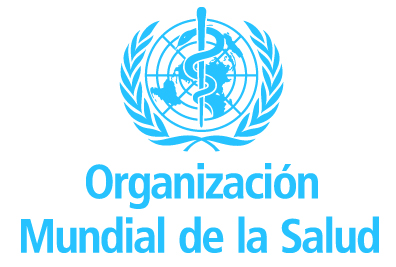
| content |
|---|
| ● Introduction (see). ● 2024-25 Northern Hemisphere influenza vaccine ingredients (see) | Reference documents | Recommended ingredients (see) | Other documents (see). ● Frequently asked questions, questions and answers from the World Health Organization (see). ● Prioritizing the use of trivalent vaccines poses problems for vaccine manufacturers, regulators and public health authorities (see). ● For more information, references and recommended links on this website (see). |
| in short |
|---|
| ● The World Health Organization has released recommendations for the composition of the northern hemisphere influenza vaccine for the upcoming 2024-25 season. ● The World Health Organization recommends the use of trivalent vaccines as a priority, regardless of the Yamagata lineage component of influenza B virus. ● Since March 2020, there has been no confirmed detection of B/Yamagata lineage influenza virus. ● The WHO’s decision with the support of the FDA is a major commitment that faces tremendous difficulties and public health challenges. |
-oOo-
introduce
Every year, the World Health Organization releases recommendations for the ingredients in next season’s flu vaccine. February in the Northern Hemisphere and August or September in the Southern Hemisphere.
These recommendations are based on multiple sources of information: influenza epidemiological surveillance, antigenic and genetic characteristics of detected viruses, serological studies, vaccine effectiveness data, antiviral drug resistance, etc.This information is displayed on the agency’s website Global Influenza Surveillance and Response System (Global GISRS).
Following review by an expert group convened by the World Health Organization, recommendations have been made for the composition of the northern hemisphere influenza vaccine for the next 2024-25 season, as set out below. The vaccine ingredients recommended for the Northern Hemisphere in 2024-25 are the same as those recommended for the Southern Hemisphere in 2024 (April to August 2024 flu season).
(back to the beginning)
2024-25 Northern Hemisphere Influenza Vaccine Ingredients
 reference document
reference document
next season, The World Health Organization recommends the use of trivalent vaccinesleaving aside the Yamagata lineage component of influenza B virus, which has not been confirmed to be isolated since March 2020, it is estimated that there is no need to include it.
(back to the beginning)
Recommended ingredients
World Health Organization recommendations trivalent vaccine Products for the 2024-2025 Northern Hemisphere influenza season include the following (see image above):
- Egg vaccine:
- Viruses similar to A/Victoria/4897/2022 (H1N1)pdm09.
- Viruses similar to A/Thailand/8/2022 (H3N2).
- Viruses similar to B/Austria/1359417/2021 (B/Victoria lineage).
- Cell culture or recombinant vaccines:
- Viruses similar to A/Wisconsin/67/2022 (H1N1)pdm09.
- Viruses similar to A/Massachusetts/18/2022 (H3N2).
- Viruses similar to B/Austria/1359417/2021 (B/Victoria lineage).
for quadrivalent vaccinein countries that decide to retain eggs, cell cultures or recombinants, WHO recommends including the following viruses as part of the B/Yamagata lineage: Lineages similar to B/Phuket/3073/2013 (B/Yamagata) ).
The World Health Organization states that from an antigenic point of view, next season’s vaccine must contain a virus similar to the one mentioned in the reference. To do this, the World Health Organization selected and authorized a group of viral strains with similar hemagglutinins so that different manufacturers could use them.
(back to the beginning)
Other files
The World Health Organization’s recommendations are accompanied by the following attached files:
(back to the beginning)
World Health Organization FAQs, Questions and Answers
Here are the World Health Organization’s answers to frequently asked questions.
How are the World Health Organization’s recommendations for influenza vaccine ingredients developed?
The WHO Global Influenza Surveillance and Response System consists of 151 influenza reference centers, 7 collaborating centers and 16 reference laboratories in 125 countries around the world. GISRS collects and analyzes data from different sources, such as those mentioned above, but also the availability of reference strains for vaccine production.
What does “virus-like” mean in vaccine ingredients?
The recommended vaccine viruses are representative of groups of antigenic viruses expected to circulate widely during the upcoming influenza season. Often, there are multiple candidate virus strains that have HA antigens from other viruses that are antigenically similar to the recommended vaccine viruses. The term “similar viruses” is included to allow the use of those other bioequivalent strains for vaccine production.
Are the B/Yamagata influenza viruses extinct?
Since March 2020, WHO has not confirmed the detection of influenza viruses of the B/Yamagata lineage. Recent reports of detection of the B/Yamagata lineage have not been confirmed or identified as live attenuated vaccine viruses.
Although it is not certain whether the B/Yamagata lineage viruses are extinct, it is unlikely that they will cause an outbreak next season. On the other hand, there is a theoretical risk of transmission associated with the use of this virus in the production of inactivated or attenuated vaccines, which is why the World Health Organization recommends excluding this strain from vaccines in use as soon as possible.
(back to the beginning)
Prioritizing the use of trivalent vaccines poses problems for vaccine manufacturers, regulators and public health authorities.
 Returning to the trivalent vaccine seems like a simple decision: “Why vaccinate against something that doesn’t exist”, “Removing an ingredient from a vaccine is as easy as removing an ingredient from a smoothie of various fruits”, These are the arguments presented. This reflects an approach that is overly simplistic and remote from complex realities. on the contrary, This is a decision with associated difficulties and very serious implications. This must be considered. It is not enough to say that the inclusion of mountain ingredients in vaccines is “no longer necessary”, which is largely true (Editorial, Lancet Infect Dis 2023; Wu KJ, The Atlantic 2024; Branswell H, STAT 2024).
Returning to the trivalent vaccine seems like a simple decision: “Why vaccinate against something that doesn’t exist”, “Removing an ingredient from a vaccine is as easy as removing an ingredient from a smoothie of various fruits”, These are the arguments presented. This reflects an approach that is overly simplistic and remote from complex realities. on the contrary, This is a decision with associated difficulties and very serious implications. This must be considered. It is not enough to say that the inclusion of mountain ingredients in vaccines is “no longer necessary”, which is largely true (Editorial, Lancet Infect Dis 2023; Wu KJ, The Atlantic 2024; Branswell H, STAT 2024).
Until 2012, only the trivalent influenza vaccine (two influenza A virus components and one influenza B virus component) was used. The spread of different variants of influenza B virus led to the use of the quadrivalent vaccine (two components of influenza A virus and two additional components of influenza B virus) in the Southern Hemisphere during the 2013 season. Since then, use of these vaccines has only increased around the world (for example, the United States is only using the quadrivalent vaccine since the 2021-22 campaign).
In September 2023, when the World Health Organization again recommended the use of trivalent vaccines (excluding the influenza B component of the Yamagata lineage) in its recommendations for the 2024 influenza season in the Southern Hemisphere, vaccine manufacturers indicated that they may be adjusting their production systems. Problems encountered in meeting regulatory requirements for new trivalent vaccines in a timely manner (Express Pharma, October 2023). However, these are not the only difficulties raised, they are also raised in other fields.
At that time, the US FDA expert committee was in full agreement with the World Health Organization and included a recommendation to return to trivalent vaccines.as soon as possible” (Avalere, October 2023). However, they explained and discussed that this decision faces various challenges in different areas (VRBPAC, FDA, October 5, 2023; Editorial, Lancet Infect Dis 2023; Wu KJ, The Atlantic 2024; Branswell H, Statistics 2024):
- inside vaccine production, as they must restart vaccine production processes that have all but ceased production. It is estimated that this situation will affect more than 350 inactive licenses that must be renewed (new efficacy studies, immunogenicity assays, etc.). Vaccine manufacturers – Seqirus, GSK and world-leading manufacturer Sanofi – have declared they are “fully committed” to the WHO’s advice, although they say this will take some time.
- inside Research new vaccinesSuch products as a universal influenza vaccine, an mRNA vaccine, and a combined vaccine against COVID-19 and influenza are being developed, taking into consideration the Yamagata lineage B virus. These surveys had to be reoriented to eliminate the gabled portion, which was costly and delayed results.
- for Regulatory Authoritywhich must evaluate and, where appropriate, approve new products, these procedures become extremely complex when they affect new products.
- And for public health authoritywho will have to: a) decide on a case-by-case basis the pace of resumption of priority or exclusive use of trivalent vaccines; b) weigh the need to maintain the Yamagata lineage during the production of inactivated vaccines, especially the continued administration of quadrivalent attenuated vaccines risk of circulating influenza viruses; c) risk of re-emergence of the virus and the dedicated use of trivalent vaccines to protect the population against multiple influenza viruses; inter alia, d) the need for a very rigorous global virological surveillance program .
Therefore, it is expected that in the coming weeks (time is tight as it will take time to make a vaccine available next autumn) manufacturers, regulators and relevant experts and authorities will make appropriate decisions to guide the deployment of the vaccine. trivalent influenza vaccine, Consider the general guidelines of the World Health Organization and the specific circumstances of each country. For its part, the US FDA has announced that it will discuss these issues as soon as Tuesday, March 5 this week.
(back to the beginning)
-oOo-
For more information please visit this website
References and referral links
- Avalere, October 5, 2023. Removing influenza B strains may affect future influenza vaccines.
- Branswell H. World Health Organization and drug regulator want to reformulate flu vaccine. easy to say, hard to do. Statistics, January 16, 2024.
- Express Pharma, October 25, 2023. WHO trivalent recommendations will reshape global influenza vaccine market: GlobalData and recommendations for the Northern Hemisphere are expected to follow suit.
- Announcement of the October 5, 2023 meeting of the U.S. FDA Vaccines and Related Biological Products Advisory Committee, October 5, 2023.
- The Lancet, Publisher. Reconstitution of influenza vaccines. Lancet Infectious Diseases. 2023;23(12):1323.
- World Health Organization, February 23, 2024. Press release. Recommendations for influenza vaccine composition for the 2024-2025 Northern Hemisphere influenza season have been published.
- World Health Organization, February 23, 2024. Recommended composition of influenza virus vaccines for use during the 2024-2025 northern hemisphere influenza season. Suggested details. ►Reviewed on: CIDRAP, February 23, 2024.
- World Health Organization, February 23, 2024. Q&A. Recommend influenza virus vaccine components for use in the 2024-2025 influenza season in the Northern Hemisphere and develop candidate vaccine viruses for pandemic prevention.
- World Health Organization, February 2024. Genetic and antigenic characterization of zoonotic influenza A viruses and development of candidate vaccine viruses for pandemic prevention.
- World Health Organization, September 29, 2023. Recommended influenza virus vaccine components for the 2024 Southern Hemisphere influenza season. ►Reviewed on: CIDRAP, September 29, 2023.
- Wu Kaijie. Flu vaccines need to stop fighting “something that doesn’t exist.” A flu virus has been gone for so long that there is no point in getting vaccinated. “The Atlantic”, February 5, 2024.
(back to the beginning)

